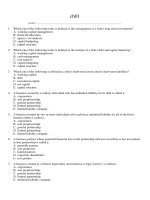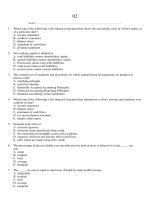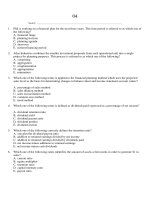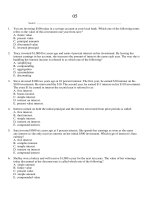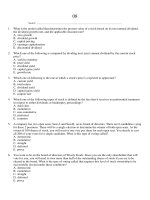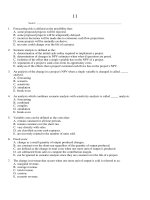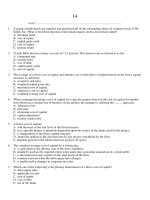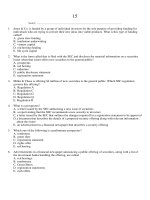Test bank fundamentals of corporate finance 9th edition chap005
Bạn đang xem bản rút gọn của tài liệu. Xem và tải ngay bản đầy đủ của tài liệu tại đây (429.1 KB, 65 trang )
Chapter 05 - Introduction to Valuation: The Time Value of Money
Chapter 05
Introduction to Valuation: The Time Value of Money
Multiple Choice Questions
1. You are investing $100 today in a savings account at your local bank. Which one of the
following terms refers to the value of this investment one year from now?
A. future value
B. present value
C. principal amounts
D. discounted value
E. invested principal
2. Tracy invested $1,000 five years ago and earns 4 percent interest on her investment. By
leaving her interest earnings in her account, she increases the amount of interest she earns
each year. The way she is handling her interest income is referred to as which one of the
following?
A. simplifying
B. compounding
C. aggregation
D. accumulation
E. discounting
3. Steve invested $100 two years ago at 10 percent interest. The first year, he earned $10
interest on his $100 investment. He reinvested the $10. The second year, he earned $11
interest on his $110 investment. The extra $1 he earned in interest the second year is referred
to as:
A. free interest.
B. bonus income.
C. simple interest.
D. interest on interest.
E. present value interest.
5-1
Chapter 05 - Introduction to Valuation: The Time Value of Money
4. Interest earned on both the initial principal and the interest reinvested from prior periods is
called:
A. free interest.
B. dual interest.
C. simple interest.
D. interest on interest.
E. compound interest.
5. Sara invested $500 six years ago at 5 percent interest. She spends her earnings as soon as
she earns any interest so she only receives interest on her initial $500 investment. Which type
of interest is Sara earning?
A. free interest
B. complex interest
C. simple interest
D. interest on interest
E. compound interest
6. Shelley won a lottery and will receive $1,000 a year for the next ten years. The value of her
winnings today discounted at her discount rate is called which one of the following?
A. single amount
B. future value
C. present value
D. simple amount
E. compounded value
7. Terry is calculating the present value of a bonus he will receive next year. The process he is
using is called:
A. growth analysis.
B. discounting.
C. accumulating.
D. compounding.
E. reducing.
5-2
Chapter 05 - Introduction to Valuation: The Time Value of Money
8. Steve just computed the present value of a $10,000 bonus he will receive in the future. The
interest rate he used in this process is referred to as which one of the following?
A. current yield
B. effective rate
C. compound rate
D. simple rate
E. discount rate
9. The process of determining the present value of future cash flows in order to know their
worth today is called which one of the following?
A. compound interest valuation
B. interest on interest computation
C. discounted cash flow valuation
D. present value interest factoring
E. complex factoring
10. Andy deposited $3,000 this morning into an account that pays 5 percent interest,
compounded annually. Barb also deposited $3,000 this morning into an account that pays 5
percent interest, compounded annually. Andy will withdraw his interest earnings and spend it
as soon as possible. Barb will reinvest her interest earnings into her account. Given this,
which one of the following statements is true?
A. Barb will earn more interest the first year than Andy will.
B. Andy will earn more interest in year three than Barb will.
C. Barb will earn interest on interest.
D. After five years, Andy and Barb will both have earned the same amount of interest.
E. Andy will earn compound interest.
11. Sue and Neal are twins. Sue invests $5,000 at 7 percent when she is 25 years old. Neal
invests $5,000 at 7 percent when he is 30 years old. Both investments compound interest
annually. Both Sue and Neal retire at age 60. Which one of the following statements is correct
assuming that neither Sue nor Neal has withdrawn any money from their accounts?
A. Sue will have less money when she retires than Neal.
B. Neal will earn more interest on interest than Sue.
C. Neal will earn more compound interest than Sue.
D. If both Sue and Neal wait to age 70 to retire, then they will have equal amounts of savings.
E. Sue will have more money than Neal as long as they retire at the same time.
5-3
Chapter 05 - Introduction to Valuation: The Time Value of Money
12. Samantha opened a savings account this morning. Her money will earn 5 percent interest,
compounded annually. After five years, her savings account will be worth $5,600. Assume she
will not make any withdrawals. Given this, which one of the following statements is true?
A. Samantha deposited more than $5,600 this morning.
B. The present value of Samantha's account is $5,600.
C. Samantha could have deposited less money and still had $5,600 in five years if she could
have earned 5.5 percent interest.
D. Samantha would have had to deposit more money to have $5,600 in five years if she could
have earned 6 percent interest.
E. Samantha will earn an equal amount of interest every year for the next five years.
13. This afternoon, you deposited $1,000 into a retirement savings account. The account will
compound interest at 6 percent annually. You will not withdraw any principal or interest until
you retire in forty years. Which one of the following statements is correct?
A. The interest you earn six years from now will equal the interest you earn ten years from
now.
B. The interest amount you earn will double in value every year.
C. The total amount of interest you will earn will equal $1,000 .06 40.
D. The present value of this investment is equal to $1,000.
E. The future value of this amount is equal to $1,000 (1 + 40).06.
14. Your grandmother has promised to give you $5,000 when you graduate from college. She
is expecting you to graduate two years from now. What happens to the present value of this
gift if you delay your graduation by one year and graduate three years from now?
A. remains constant
B. increases
C. decreases
D. becomes negative
E. cannot be determined from the information provided
5-4
Chapter 05 - Introduction to Valuation: The Time Value of Money
15. Luis is going to receive $20,000 six years from now. Soo Lee is going to receive $20,000
nine years from now. Which one of the following statements is correct if both Luis and Soo
Lee apply a 7 percent discount rate to these amounts?
A. The present values of Luis and Soo Lee's monies are equal.
B. In future dollars, Soo Lee's money is worth more than Luis' money.
C. In today's dollars, Luis' money is worth more than Soo Lee's.
D. Twenty years from now, the value of Luis' money will be equal to the value of Soo Lee's
money.
E. Soo Lee's money is worth more than Luis' money given the 7 percent discount rate.
16. Which one of the following variables is the exponent in the present value formula?
A. present value
B. future value
C. interest rate
D. time
E. There is no exponent in the present value formula.
17. You want to have $1 million in your savings account when you retire. You plan on
investing a single lump sum today to fund this goal. You are planning on investing in an
account which will pay 7.5 percent annual interest. Which of the following will reduce the
amount that you must deposit today if you are to have your desired $1 million on the day you
retire?
I. Invest in a different account paying a higher rate of interest.
II. Invest in a different account paying a lower rate of interest.
III. Retire later.
IV. Retire sooner.
A. I only
B. II only
C. I and III only
D. I and IV only
E. II and III only
5-5
Chapter 05 - Introduction to Valuation: The Time Value of Money
18. Which one of the following will produce the highest present value interest factor?
A. 6 percent interest for five years
B. 6 percent interest for eight years
C. 6 percent interest for ten years
D. 8 percent interest for five years
E. 8 percent interest for ten years
19. What is the relationship between present value and future value interest factors?
A. The present value and future value factors are equal to each other.
B. The present value factor is the exponent of the future value factor.
C. The future value factor is the exponent of the present value factor.
D. The factors are reciprocals of each other.
E. There is no relationship between these two factors.
20. Martin invested $1,000 six years ago and expected to have $1,500 today. He has not added
or withdrawn any money from this account since his initial investment. All interest was
reinvested in the account. As it turns out, Martin only has $1,420 in his account today. Which
one of the following must be true?
A. Martin earned simple interest rather than compound interest.
B. Martin earned a lower interest rate than he expected.
C. Martin did not earn any interest on interest as he expected.
D. Martin ignored the Rule of 72 which caused his account to decrease in value.
E. The future value interest factor turned out to be higher than Martin expected.
21. Gerold invested $6,200 in an account that pays 5 percent simple interest. How much
money will he have at the end of ten years?
A. $8,710
B. $9,000
C. $9,300
D. $9,678
E. $10,099
5-6
Chapter 05 - Introduction to Valuation: The Time Value of Money
22. Alex invested $10,500 in an account that pays 6 percent simple interest. How much
money will he have at the end of four years?
A. $12,650
B. $12,967
C. $13,020
D. $13,256
E. $13,500
23. You invested $1,650 in an account that pays 5 percent simple interest. How much more
could you have earned over a 20-year period if the interest had compounded annually?
A. $849.22
B. $930.11
C. $982.19
D. $1,021.15
E. $1,077.94
24. Travis invested $9,250 in an account that pays 6 percent simple interest. How much more
could he have earned over a 7-year period if the interest had compounded annually?
A. $741.41
B. $773.58
C. $802.16
D. $833.33
E. $858.09
25. What is the future value of $7,189 invested for 23 years at 9.25 percent compounded
annually?
A. $22,483.60
B. $27,890.87
C. $38,991.07
D. $51,009.13
E. $54,999.88
5-7
Chapter 05 - Introduction to Valuation: The Time Value of Money
26. Today, you earn a salary of $36,000. What will be your annual salary twelve years from
now if you earn annual raises of 3.6 percent?
A. $55,032.54
B. $57,414.06
C. $58,235.24
D. $59,122.08
E. $59,360.45
27. You own a classic automobile that is currently valued at $147,900. If the value increases
by 6.5 percent annually, how much will the automobile be worth ten years from now?
A. $244,035.00
B. $251,008.17
C. $270,013.38
D. $277,628.63
E. $291,480.18
28. You hope to buy your dream car four years from now. Today, that car costs $82,500. You
expect the price to increase by an average of 4.8 percent per year over the next four years.
How much will your dream car cost by the time you are ready to buy it?
A. $98,340.00
B. $98,666.67
C. $99,517.41
D. $99,818.02
E. $100,023.16
29. This morning, TL Trucking invested $80,000 to help fund a company expansion project
planned for 4 years from now. How much additional money will the firm have 4 years from
now if it can earn 5 percent rather than 4 percent on its savings?
A. $2,940.09
B. $3,651.82
C. $4,008.17
D. $4,219.68
E. $4,711.08
5-8
Chapter 05 - Introduction to Valuation: The Time Value of Money
30. You just received $225,000 from an insurance settlement. You have decided to set this
money aside and invest it for your retirement. Currently, your goal is to retire 25 years from
today. How much more will you have in your account on the day you retire if you can earn an
average return of 10.5 percent rather than just 8 percent?
A. $417,137
B. $689,509
C. $1,050,423
D. $1,189,576
E. $1,818,342
31. You just received a $5,000 gift from your grandmother. You have decided to save this
money so that you can gift it to your grandchildren 50 years from now. How much additional
money will you have to gift to your grandchildren if you can earn an average of 8.5 percent
instead of just 8 percent on your savings?
A. $47,318.09
B. $52,464.79
C. $55,211.16
D. $58,811.99
E. $60,923.52
32. You are depositing $1,500 in a retirement account today and expect to earn an average
return of 7.5 percent on this money. How much additional income will you earn if you leave
the money invested for 45 years instead of just 40 years?
A. $10,723.08
B. $11,790.90
C. $12,441.56
D. $12,908.19
E. $13,590.93
5-9
Chapter 05 - Introduction to Valuation: The Time Value of Money
33. You collect old coins. Today, you have two coins each of which is valued at $250. One
coin is expected to increase in value by 6 percent annually while the other coin is expected to
increase in value by 4.5 percent annually. What will be the difference in the value of the two
coins 15 years from now?
A. $115.32
B. $208.04
C. $241.79
D. $254.24
E. $280.15
34. Your father invested a lump sum 26 years ago at 4.25 percent interest. Today, he gave you
the proceeds of that investment which totaled $51,480.79. How much did your father
originally invest?
A. $15,929.47
B. $16,500.00
C. $17,444.86
D. $17,500.00
E. $17,999.45
35. What is the present value of $150,000 to be received 8 years from today if the discount
rate is 11 percent?
A. $65,088.97
B. $71,147.07
C. $74,141.41
D. $79,806.18
E. $83,291.06
36. You would like to give your daughter $75,000 towards her college education 17 years
from now. How much money must you set aside today for this purpose if you can earn 8
percent on your investments?
A. $18,388.19
B. $20,270.17
C. $28,417.67
D. $29,311.13
E. $32,488.37
5-10
Chapter 05 - Introduction to Valuation: The Time Value of Money
37. You want to have $35,000 saved 6 years from now to buy a house. How much less do you
have to deposit today to reach this goal if you can earn 5.5 percent rather than 5 percent on
your savings? Today's deposit is the only deposit you will make to this savings account.
A. $733.94
B. $791.18
C. $824.60
D. $845.11
E. $919.02
38. Your older sister deposited $5,000 today at 8.5 percent interest for 5 years. You would like
to have just as much money at the end of the next 5 years as your sister will have. However,
you can only earn 7 percent interest. How much more money must you deposit today than
your sister did if you are to have the same amount at the end of the 5 years?
A. $321.19
B. $360.43
C. $387.78
D. $401.21
E. $413.39
39. A year ago, you deposited $30,000 into a retirement savings account at a fixed rate of 5.5
percent. Today, you could earn a fixed rate of 6.5 percent on a similar type account. However,
your rate is fixed and cannot be adjusted. How much less could you have deposited last year if
you could have earned a fixed rate of 6.5 percent and still have the same amount as you
currently will when you retire 38 years from today?
A. $2,118.42 less
B. $3,333.33 less
C. $5,417.09 less
D. $7,274.12 less
E. $9,234.97 less
5-11
Chapter 05 - Introduction to Valuation: The Time Value of Money
40. When you retire 40 years from now, you want to have $1.2 million. You think you can
earn an average of 12 percent on your investments. To meet your goal, you are trying to
decide whether to deposit a lump sum today, or to wait and deposit a lump sum 2 years from
today. How much more will you have to deposit as a lump sum if you wait for 2 years before
making the deposit?
A. $1,414.14
B. $2,319.47
C. $2,891.11
D. $3,280.78
E. $3,406.78
41. Theo needs $40,000 as a down payment for a house 6 years from now. He earns 3.5
percent on his savings. Theo can either deposit one lump sum today for this purpose or he can
wait a year and deposit a lump sum. How much additional money must he deposit if he waits
for one year rather than making the deposit today?
A. $878.98
B. $911.13
C. $1,138.90
D. $1,348.03
E. $1,420.18
42. One year ago, you invested $1,800. Today it is worth $1,924.62. What rate of interest did
you earn?
A. 6.59 percent
B. 6.67 percent
C. 6.88 percent
D. 6.92 percent
E. 7.01 percent
43. According to the Rule of 72, you can do which one of the following?
A. double your money in five years at 7.2 percent interest
B. double your money in 7.2 years at 8 percent interest
C. double your money in 8 years at 9 percent interest
D. triple your money in 7.2 years at 5 percent interest
E. triple your money at 10 percent interest in 7.2 years
5-12
Chapter 05 - Introduction to Valuation: The Time Value of Money
44. Forty years ago, your mother invested $5,000. Today, that investment is worth
$430,065.11. What is the average annual rate of return she earned on this investment?
A. 11.68 percent
B. 11.71 percent
C. 11.78 percent
D. 11.91 percent
E. 12.02 percent
45. Sixteen years ago, Alicia invested $1,000. Eight years ago, Travis invested $2,000. Today,
both Alicia's and Travis' investments are each worth $2,400. Assume that both Alicia and
Travis continue to earn their respective rates of return. Which one of the following statements
is correct concerning these investments?
A. Three years from today, Travis' investment will be worth more than Alicia's.
B. One year ago, Alicia's investment was worth less than Travis' investment.
C. Travis earns a higher rate of return than Alicia.
D. Travis has earned an average annual interest rate of 3.37 percent.
E. Alicia has earned an average annual interest rate of 6.01 percent.
46. Penn Station is saving money to build a new loading platform. Two years ago, they set
aside $24,000 for this purpose. Today, that account is worth $28,399. What rate of interest is
Penn Station earning on this investment?
A. 6.39 percent
B. 7.47 percent
C. 8.78 percent
D. 9.23 percent
E. 9.67 percent
47. Fifteen years ago, Jackson Supply set aside $130,000 in case of a financial emergency.
Today, that account has increased in value to $330,592. What rate of interest is the firm
earning on this money?
A. 5.80 percent
B. 6.42 percent
C. 6.75 percent
D. 7.28 percent
E. 7.53 percent
5-13
Chapter 05 - Introduction to Valuation: The Time Value of Money
48. Fourteen years ago, your parents set aside $7,500 to help fund your college education.
Today, that fund is valued at $26,180. What rate of interest is being earned on this account?
A. 7.99 percent
B. 8.36 percent
C. 8.51 percent
D. 9.34 percent
E. 10.06 percent
49. Some time ago, Julie purchased eleven acres of land costing $36,900. Today, that land is
valued at $214,800. How long has she owned this land if the price of the land has been
increasing at 10.5 percent per year?
A. 13.33 years
B. 16.98 years
C. 17.64 years
D. 19.29 years
E. 21.08 years
50. On your ninth birthday, you received $300 which you invested at 4.5 percent interest,
compounded annually. Your investment is now worth $756. How old are you today?
A. age 29
B. age 30
C. age 31
D. age 32
E. age 33
Essay Questions
51. You want to deposit sufficient money today into a savings account so that you will have
$1,000 in the account three years from today. Explain why you could deposit less money
today if you could earn 3.5 percent interest rather than 3 percent interest.
5-14
Chapter 05 - Introduction to Valuation: The Time Value of Money
52. You are considering two separate investments. Both investments pay 7 percent interest.
Investment A pays simple interest and Investment B pays compound interest. Which
investment should you choose, and why, if you plan on investing for a period of 5 years?
53. What lesson does the future value formula provide for young workers who are looking
ahead to retiring some day?
54. You are considering two lottery payment options: Option A pays $10,000 today and
Option B pays $20,000 at the end of ten years. Assume you can earn 6 percent on your
savings. Which option will you choose if you base your decision on present values? Which
option will you choose if you base your decision on future values? Explain why your answers
are either the same or different.
5-15
Chapter 05 - Introduction to Valuation: The Time Value of Money
55. At an interest rate of 10 percent and using the Rule of 72, how long will it take to double
the value of a lump sum invested today? How long will it take after that until the account
grows to four times the initial investment? Given the power of compounding, shouldn't it take
less time for the money to double the second time?
Multiple Choice Questions
56. Assume the total cost of a college education will be $300,000 when your child enters
college in 16 years. You presently have $75,561 to invest. What rate of interest must you earn
on your investment to cover the cost of your child's college education?
A. 7.75 percent
B. 8.50 percent
C. 9.00 percent
D. 9.25 percent
E. 9.50 percent
57. At 11 percent interest, how long would it take to quadruple your money?
A. 6.55 years
B. 6.64 years
C. 13.09 years
D. 13.28 years
E. 13.56 years
58. Assume the average vehicle selling price in the United States last year was $41,996. The
average price 9 years earlier was $29,000. What was the annual increase in the selling price
over this time period?
A. 3.89 percent
B. 4.20 percent
C. 4.56 percent
D. 5.01 percent
E. 5.40 percent
5-16
Chapter 05 - Introduction to Valuation: The Time Value of Money
59. You're trying to save to buy a new $160,000 Ferrari. You have $56,000 today that can be
invested at your bank. The bank pays 6 percent annual interest on its accounts. How many
years will it be before you have enough to buy the car? Assume the price of the car remains
constant.
A. 16.67 years
B. 17.04 years
C. 17.41 years
D. 17.87 years
E. 18.02 years
60. Imprudential, Inc. has an unfunded pension liability of $850 million that must be paid in
25 years. To assess the value of the firm's stock, financial analysts want to discount this
liability back to the present. The relevant discount rate is 6.5 percent. What is the present
value of this liability?
A. $159,803,162
B. $171,438,907
C. $176,067,311
D. $184,519,484
E. $191,511,367
61. You have just received notification that you have won the $1.4 million first prize in the
Centennial Lottery. However, the prize will be awarded on your 100th birthday, 70 years from
now. The appropriate discount rate is 8 percent. What is the present value of your winnings?
A. $4,288.16
B. $6,404.20
C. $15,309.91
D. $23,333.33
E. $25,000.00
62. Your coin collection contains fifty-four 1941 silver dollars. Your grandparents purchased
them for their face value when they were new. These coins have appreciated at a 10 percent
annual rate. How much will your collection be worth when you retire in 2060?
A. $3,611,008
B. $3,987,456
C. $4,122,394
D. $4,421,008
E. $4,551,172
5-17
Chapter 05 - Introduction to Valuation: The Time Value of Money
63. In 1895, the winner of a competition was paid $110. In 2006, the winner's prize was
$70,000. What will the winner's prize be in 2040 if the prize continues increasing at the same
rate?
A. $389,400
B. $421,122
C. $479,311
D. $505,697
E. $548,121
64. Suppose that the first comic book of a classic series was sold in 1954. In 2000, the
estimated price for this comic book in good condition was about $340,000. This represented a
return of 27 percent per year. For this to be true, what was the original price of the comic book
in 1954?
A. $5.00
B. $5.28
C. $5.50
D. $5.71
E. $6.00
65. Suppose you are committed to owning a $140,000 Ferrari. You believe your mutual fund
can achieve an annual rate of return of 9 percent and you want to buy the car in 7 years. How
much must you invest today to fund this purchase assuming the price of the car remains
constant?
A. $74,208.16
B. $76,584.79
C. $77,911.08
D. $78,019.82
E. $79,446.60
5-18
Chapter 05 - Introduction to Valuation: The Time Value of Money
66. You have just made a $1,500 contribution to your individual retirement account. Assume
you earn a 12 percent rate of return and make no additional contributions. How much more
will your account be worth when you retire in 25 years than it would be if you waited another
10 years before making this contribution?
A. $8,306.16
B. $9,658.77
C. $16,311.18
D. $16,907.17
E. $17,289.75
67. You are scheduled to receive $30,000 in two years. When you receive it, you will invest it
for 5 more years, at 8 percent per year. How much money will you have 7 years from now?
A. $39,909.19
B. $41,381.16
C. $44,079.84
D. $47,209.19
E. $51,414.73
68. You expect to receive $9,000 at graduation in 2 years. You plan on investing this money at
10 percent until you have $60,000. How many years will it be until this occurs?
A. 18.78 years
B. 19.96 years
C. 21.90 years
D. 23.08 years
E. 25.00 years
5-19
Chapter 05 - Introduction to Valuation: The Time Value of Money
Chapter 05 Introduction to Valuation: The Time Value of Money Answer Key
Multiple Choice Questions
1. You are investing $100 today in a savings account at your local bank. Which one of the
following terms refers to the value of this investment one year from now?
A. future value
B. present value
C. principal amounts
D. discounted value
E. invested principal
Refer to section 5.1
AACSB: N/A
Bloom's: Knowledge
Difficulty: Basic
Learning Objective: 5-1
Section: 5.1
Topic: Future value
2. Tracy invested $1,000 five years ago and earns 4 percent interest on her investment. By
leaving her interest earnings in her account, she increases the amount of interest she earns
each year. The way she is handling her interest income is referred to as which one of the
following?
A. simplifying
B. compounding
C. aggregation
D. accumulation
E. discounting
Refer to section 5.1
AACSB: N/A
Bloom's: Knowledge
Difficulty: Basic
Learning Objective: 5-1
Section: 5.1
Topic: Compounding
5-20
Chapter 05 - Introduction to Valuation: The Time Value of Money
3. Steve invested $100 two years ago at 10 percent interest. The first year, he earned $10
interest on his $100 investment. He reinvested the $10. The second year, he earned $11
interest on his $110 investment. The extra $1 he earned in interest the second year is referred
to as:
A. free interest.
B. bonus income.
C. simple interest.
D. interest on interest.
E. present value interest.
Refer to section 5.1
AACSB: N/A
Bloom's: Knowledge
Difficulty: Basic
Learning Objective: 5-1
Section: 5.1
Topic: Interest on interest
4. Interest earned on both the initial principal and the interest reinvested from prior periods is
called:
A. free interest.
B. dual interest.
C. simple interest.
D. interest on interest.
E. compound interest.
Refer to section 5.1
AACSB: N/A
Bloom's: Knowledge
Difficulty: Basic
Learning Objective: 5-1
Section: 5.1
Topic: Compound interest
5-21
Chapter 05 - Introduction to Valuation: The Time Value of Money
5. Sara invested $500 six years ago at 5 percent interest. She spends her earnings as soon as
she earns any interest so she only receives interest on her initial $500 investment. Which type
of interest is Sara earning?
A. free interest
B. complex interest
C. simple interest
D. interest on interest
E. compound interest
Refer to section 5.1
AACSB: N/A
Bloom's: Knowledge
Difficulty: Basic
Learning Objective: 5-1
Section: 5.1
Topic: Simple interest
6. Shelley won a lottery and will receive $1,000 a year for the next ten years. The value of her
winnings today discounted at her discount rate is called which one of the following?
A. single amount
B. future value
C. present value
D. simple amount
E. compounded value
Refer to section 5.2
AACSB: N/A
Bloom's: Knowledge
Difficulty: Basic
Learning Objective: 5-2
Section: 5.2
Topic: Present value
5-22
Chapter 05 - Introduction to Valuation: The Time Value of Money
7. Terry is calculating the present value of a bonus he will receive next year. The process he is
using is called:
A. growth analysis.
B. discounting.
C. accumulating.
D. compounding.
E. reducing.
Refer to section 5.2
AACSB: N/A
Bloom's: Knowledge
Difficulty: Basic
Learning Objective: 5-2
Section: 5.2
Topic: Discounting
8. Steve just computed the present value of a $10,000 bonus he will receive in the future. The
interest rate he used in this process is referred to as which one of the following?
A. current yield
B. effective rate
C. compound rate
D. simple rate
E. discount rate
Refer to section 5.2
AACSB: N/A
Bloom's: Knowledge
Difficulty: Basic
Learning Objective: 5-2
Section: 5.2
Topic: Discount rate
5-23
Chapter 05 - Introduction to Valuation: The Time Value of Money
9. The process of determining the present value of future cash flows in order to know their
worth today is called which one of the following?
A. compound interest valuation
B. interest on interest computation
C. discounted cash flow valuation
D. present value interest factoring
E. complex factoring
Refer to section 5.2
AACSB: N/A
Bloom's: Knowledge
Difficulty: Basic
Learning Objective: 5-2
Section: 5.2
Topic: Discounted cash flow valuation
10. Andy deposited $3,000 this morning into an account that pays 5 percent interest,
compounded annually. Barb also deposited $3,000 this morning into an account that pays 5
percent interest, compounded annually. Andy will withdraw his interest earnings and spend it
as soon as possible. Barb will reinvest her interest earnings into her account. Given this,
which one of the following statements is true?
A. Barb will earn more interest the first year than Andy will.
B. Andy will earn more interest in year three than Barb will.
C. Barb will earn interest on interest.
D. After five years, Andy and Barb will both have earned the same amount of interest.
E. Andy will earn compound interest.
Refer to section 5.1
AACSB: N/A
Bloom's: Comprehension
Difficulty: Basic
Learning Objective: 5-1
Section: 5.1
Topic: Compound interest
5-24
Chapter 05 - Introduction to Valuation: The Time Value of Money
11. Sue and Neal are twins. Sue invests $5,000 at 7 percent when she is 25 years old. Neal
invests $5,000 at 7 percent when he is 30 years old. Both investments compound interest
annually. Both Sue and Neal retire at age 60. Which one of the following statements is correct
assuming that neither Sue nor Neal has withdrawn any money from their accounts?
A. Sue will have less money when she retires than Neal.
B. Neal will earn more interest on interest than Sue.
C. Neal will earn more compound interest than Sue.
D. If both Sue and Neal wait to age 70 to retire, then they will have equal amounts of savings.
E. Sue will have more money than Neal as long as they retire at the same time.
Refer to section 5.1
AACSB: N/A
Bloom's: Comprehension
Difficulty: Basic
Learning Objective: 5-1
Section: 5.1
Topic: Future value
12. Samantha opened a savings account this morning. Her money will earn 5 percent interest,
compounded annually. After five years, her savings account will be worth $5,600. Assume she
will not make any withdrawals. Given this, which one of the following statements is true?
A. Samantha deposited more than $5,600 this morning.
B. The present value of Samantha's account is $5,600.
C. Samantha could have deposited less money and still had $5,600 in five years if she could
have earned 5.5 percent interest.
D. Samantha would have had to deposit more money to have $5,600 in five years if she could
have earned 6 percent interest.
E. Samantha will earn an equal amount of interest every year for the next five years.
Refer to section 5.2
AACSB: N/A
Bloom's: Comprehension
Difficulty: Intermediate
Learning Objective: 5-2
Section: 5.2
Topic: Present value
5-25
